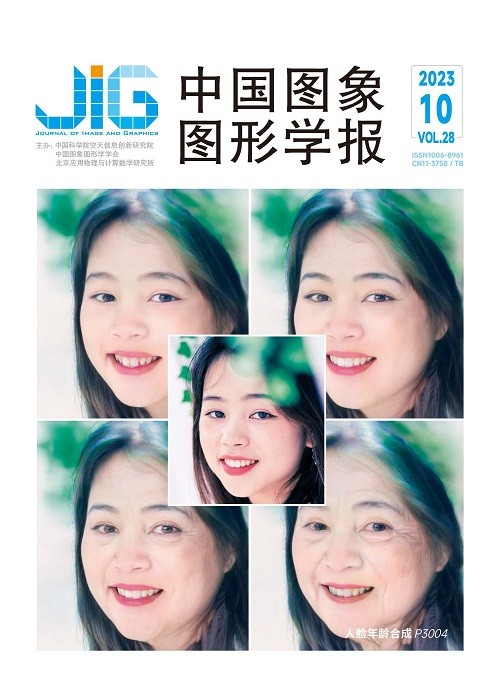
引入高斯掩膜的相关滤波目标跟踪算法
摘 要
目的 由于相关滤波(correlation filter,CF)跟踪算法使用循环移位操作增加训练样本,不可避免会引起边界效应问题。研究者大多采用余弦窗来抑制边界效应,但余弦窗的引入会导致样本污染,降低了算法的性能。为解决该问题,提出了嵌入高斯形状掩膜的相关滤波跟踪算法。方法 在空间正则化相关滤波跟踪框架中嵌入高斯形状掩膜,对靠近目标中心和搜索区域边缘的样本重新分配权重,提高中心样本的重要性,同时降低远离中心的边缘样本的重要性,增加中心样本的响应,从而降低样本污染的影响,增强滤波器的判别能力。建立了高斯掩膜相关滤波跟踪算法的目标公式,然后使用交替方向乘子法(alternating direction of multiplier method,ADMM)求解滤波器及空间权重的闭合解。结果 为评估所提算法的跟踪性能,在OTB2013 (online tracking benchmark)、TC128 (temple color)、UAV123 (unmmaned aerial vehicle)及Got-10k (general object tracking)等多个基准数据集上进行了大量实验,并与多个先进的相关滤波跟踪算法对比。结果表明,在OTB2013数据集上精度和成功率分别为90.2%和65.2%,其中精度比基准算法提高0.5%;在TC128数据集上精度和成功率分别为77.9%和57.7%,其中成功率提高0.4%;UAV123数据集上的两个指标数据分别为74.1%和50.8%,精度提高0.3%;在Got-10k数据集上成功率提高了0.2%。结论 与其他相关滤波跟踪算法相比,本文算法在各数据集上的精度和成功率表现出较强的竞争力,显著提高了基准算法的跟踪性能。
关键词
A Gaussian mask-based correlation filter tracking algorithm
Wang Fasheng, Yin Shuangshuang, He Bing, Sun Fuming(School of Information and Communication Engineering, Dalian Minzu University, Dalian 116600, China) Abstract
Objective Object tracking has been concerned more as such a domain in relevance to computer vision. In the past decade,correlation filter has been recognized for object tracking due to its high accuracy and speed. For traditional correlation filter tracking algorithms,training sample set is generated using circulant shift operation on the underlying image patches,and the circulant matrix is used to compute in the Fourier domain as well,which can improve the learning efficiency further. However,due to Fourier transform is used periodically,the boundary of the image is not involved in computing. Consequently,the boundary of the object-tracking sample is discontinuous,resulting in the annoying boundary effect. The error and inquality of samples can be generated,which affects the filter ability severely. Two sorts of popular solutions are employed to resolve the boundary effects currently. The first one is oriented to draw real negative samples from the sampling area. But,all of the negative and positive samples are assigned equal weights,which cannot well suppress the boundary effect. The other one is focused on an integrated spatial regularization term relevant to the correlation filter framework. A defined spatial weight map is used to deal with boundary area-near spatial weights of the samples. However,spatial regularization weight map is defined in the first frame,and such related invariant can be kept during tracking,which is not melted into the variation of different object. Both of the two sorts of solutions are required to suppress boundary effects using cosine window. The introduction of cosine window is linked to the problem of sample contamination simultaneously. The generated samples are distorted by redundant pixels,for which the tracking performance is eroded. To resolve this problem,we develop a Gaussian mask-based correlation filter tracking algorithm. Method Gaussian shape mask is embedded into the spatially regularized correlation filter framework. It redefines the weight of the samples close to the object center and those next to the boundary of the sampling region,which strengthens the weight of the samples the object center and weakens the weight of the samples far away from the object center. Thus,the response of the samples close to the object center could be enhanced while those boundary area-near samples are suppressed. To improve the tracking performance, its related strategy can be implemented to suppress the boundary effect and shrink cosine window-caused sample contamination problem. The objective function of the proposed Gaussian mask correlation filter is configured out,and to obtain closed-form solutions of the filter and spatial weights,it is then solved using alternating direction of multiplier method. To deal with scale estimation problem,two sort of correlation filters are trained in terms of location and scale filters. The location filter is trained using histogram of gradient(HOG) feature and Visual Geometry Group(VGG) network-derived deep features,while the scale filter is trained using five-scale HOG features. The former one is mainly used for estimating the object location,while the latter one is used to determine the best scale of the target object. Result To evaluate the proposed Gaussian mask correlation filter,extensive experiments are carried out on several tracking benchmark datasets relevant to OTB2013,TC128,UAV123 and Got-10k,and comparative analysis is linked to such popular correlation filter based tracking methods like LADCF,ASRCF,RHCF and ECO. We use the general one-pass evaluation standard to evaluate all the tracking methods. For the evaluation metrics,the precision score and success rate are used and all the tracking methods are ranked according to the precision score in the precision plots and area under curve score in the success plots. The experimental results demonstrate that each of the OTB2013 dataset-relevant precision and success score is reached to 90. 2% and 65. 2%,in which the precision score is optimized by 0. 5% over the baseline tracking method. For TC128 dataset,the values of the two metrics are 77. 9% and 57. 7%,where the success score is improved by 0. 4 over the baseline tracking method. For UAV123 dataset,each of the two sorts of scores can be reached to 74. 1% and 50. 8%,where the precision score is improved by 0. 3% compared to the baseline tracking method. For Got-10k dataset,the success rate is improved by 0. 2% compared to the baseline tracking method. The qualitative results illustrate that our proposed method can be used to deal with such challenging issues like deformation,occlusion,out of view and fast motion. However,the limitation shows that computational cost of the proposed method is inevitable due to the introduction of the Gaussian mask. In addition,VGG network based deep features can increase the computational cost as well. For Got-10k dataset,the frame rate is about 5. 2 frames per second,while the baseline tracking method is 5. 43 frames per second,which realizes 0. 23 frames per second higher. Conclusion The Gaussian mask is melted into the correlation filter framework,which can suppress the boundary effect and resolve the sample contamination problem. The sample weights are redistributed to highlight the samples near the object center,while the weight of the samples far away from the object center are suppressed. Extensive experimental results demonstrate that the proposed strategy is effective to some extent. Compared to other related correlation filter based trackers,our proposed method has its potentials on four public benchmark datasets in terms of tracking precision and success rate,which can improves the tracking performance of the baseline tracking method further. Guassian mask can also be extended to other related correlation filter based tracking framework potentially. The introduction of the Gaussian mask can decrease the tracking speed. Our future work will focus on this problem.
Keywords
|



 中国图象图形学报 │ 京ICP备05080539号-4 │ 本系统由
中国图象图形学报 │ 京ICP备05080539号-4 │ 本系统由